Spatial and Functional Heterogeneity in Regional Resilience: A GIS-Based Analysis of the Chengdu–Chongqing Economic Mega Region
Abstract
1. Introduction
2. Concise Literature Review
2.1. Conceptual Evolution Toward Functional Integration
2.2. Overview and Limitations of Regional Resilience Frameworks
- Sustainable Livelihood Approach (SLA): Focuses on rural livelihood assets and vulnerability [26], but neglects urban–ecological synergies essential for territorial planning.
- PEOPLES Framework: Integrates population, infrastructure, economy, and social dimensions [24], yet overlooks agricultural functional resilience, a core pillar of China’s Three Major Spatial Patterns.
- Pressure–State–Response (PSR) Model: Emphasizes ecological dynamics and environmental stressors [25] but demonstrates weak integration of socioeconomic systems.
- Regional Resilience Process–Outcome (RRPO) Framework: Captures temporal changes and adaptive processes [23] but fails to bridge urban–agricultural–ecological interdependencies.
- Community Resilience Frameworks: Highlight social capital, governance, and adaptive capacity [34].
- Urban Resilience Index (URI): Quantifies urban infrastructure and service robustness [36].
2.3. GIS as a Tool for Functional Integration
2.4. Research Gap: Lack of Functional Integration Metrics
2.5. Research Objectives for Functional Integration
3. Study Region and Relevant Data
3.1. Region Overview
3.2. Data Sources and Preprocessing
4. Methods and Models
4.1. Integrated Functional Resilience Framework
4.2. Resilience Assessment Protocol
- (1)
- Indicator Selection. Domain-specific metrics identified through literature review and policy alignment.
- (2)
- Data Normalization. Min–Max scaling applied to all indicators:
- (3)
- Weight Assignment. For urban resilience, a Delphi–AHP hybrid approach combined expert judgment with hierarchical pairwise comparisons; for agricultural resilience, the entropy method objectively weighted indicators based on inter-district variability; and for ecological resilience, literature-derived weights were synthesized from established ecosystem valuation studies.
- (4)
- Dimension-Specific Modeling. Dimension-specific modeling approaches were implemented: KL-TOPSIS quantified urban resilience through multi-criteria decision analysis under uncertainty; categorical scoring with tiered classification assessed agricultural resilience across discrete environmental conditions; and ecological resilience was computed through the integrated synthesis of Risk–Recovery–Potential (RRP) components. Each methodology was deliberately aligned with the functional characteristics of its respective spatial zone.
- (5)
- GIS Integration. The final stage employed GIS integration to synthesize all dimension-specific outputs through raster-based spatial analysis at 1000 m resolution, ensuring consistent cross-dimensional comparability while enabling the precise mapping of functional zone interactions across the CCEMR.
4.3. Urban Resilience Assessment
4.3.1. Indicator System
- Infrastructure: Area of parkland per capita (APPC), water, electricity, and gas supply capacity (WEGSC), road area per capita (RAPC), and conditions in health facilities (CHF).
- Economic: Gross domestic product (GDP), GDP per capita, public financial expenditure (PFE), fixed assets investment in public facilities (FAIPF), and residents’ savings deposit balance (RSDB).
- Social: Population, population density (PD), leadership levels (LSL), urbanization rates (UR), community self-organization (CSO), and housing area per capita (HAPC).
- Environmental: Sewage treatment rate (STR), domestic waste disposal rate (DWDR), green rate (GR), industrial solid waste utilization rate (ISWUR), and PM2.5 concentration.
4.3.2. Weight Assignment
4.3.3. Modeling
4.4. Agricultural Resilience Assessment
4.4.1. Indicator System
- Natural Factors: altitude (Alt), relief degree of land surface (RDLS), soil sand content (SSC), precipitation (Pre), temperature (Tem), and hours of sunshine (HSSs);
- Human Factors: the amount of investment in farming, forestry, animal husbandry, and fishery (AIFFAHF), the amount of fertilizer applied (AFA), and rural electricity consumption (AEURA).
4.4.2. Weight Assignment
4.4.3. Modeling
4.5. Ecological Resilience Assessment
4.5.1. Risk–Recovery–Potential Model Framework
- Risk (Pressure): Land-use disturbance intensity;
- Recovery (State): Autonomous regeneration capacity;
- Potential (Response): Ecosystem service value provision.
4.5.2. Component Quantification
- (1)
- Ecosystem Risk Index (ERI)where is the Ecosystem Risk Index, is the area of the i-th land-use type, A is the total area of the grid, and is the weight representing the ecological risk intensity of the corresponding land-use type.Computations are performed across 2098 hexagonal grid cells (10 km × 10 km), with each cell’s centroid representing localized risk.
- (2)
- Ecosystem Recovery (ERC)
- (3)
- Ecosystem Service Value (ESV)
4.5.3. Integration
4.6. Regional Resilience Integration
4.7. Methods Synthesis
5. Results
5.1. Dimension-Specific Resilience Patterns
5.2. Integrated Regional Resilience
- Low (0.07–0.23): Ya’an mountains (3.73%, );
- Relatively Low (0.23–0.38): 72.72% of CCEMR, ;
- Moderate (0.38–0.54): Transitional farmlands (22.26%, );
- Relatively High (0.54–0.69): Nanchong/Guang’an (1.28%, );
- High (0.69–0.85): Chengdu’s core (0.01%, ).
5.3. Policy-Weighting Sensitivities
5.4. Bivariate Local Moran’s I Analysis of Resilience Dimension Associations
5.5. Resilience-Informed Functional Zoning Framework
6. Discussion
7. Conclusions
Author Contributions
Funding
Data Availability Statement
Conflicts of Interest
Appendix A. Detailed Calculation Steps for the KL-TOPSIS Model
References
- Tang, L.; Ke, X.; Chen, Y.; Wang, L.; Zhou, Q.; Zheng, W.; Xiao, B. Which impacts more seriously on natural habitat loss and degradation? Cropland expansion or urban expansion? Land Degrad. Dev. 2021, 32, 946–964. [Google Scholar] [CrossRef]
- Liu, N.; Liu, Z.; Wu, Y. Direct and Indirect Impacts of Urbanization on Biodiversity Across the World’s Cities. Remote Sens. 2025, 17, 956. [Google Scholar] [CrossRef]
- d’Amour, C.B.; Reitsma, F.; Baiocchi, G.; Barthel, S.; Güneralp, B.; Erb, K.H.; Haberl, H.; Creutzig, F.; Seto, K.C. Future urban land expansion and implications for global croplands. Proc. Natl. Acad. Sci. USA 2017, 114, 8939–8944. [Google Scholar] [CrossRef]
- UNCCD, Urbanization. Global Land Outlook; United Nations Convention to Combat Desertification: Bonn, Germany, 2017; Chapter 11; pp. 226–245. [Google Scholar]
- Saleem, A.; Anwar, S.; Nawaz, T.; Fahad, S.; Saud, S.; Ur Rahman, T.; Khan, M.N.R.; Nawaz, T. Securing a sustainable future: The climate change threat to agriculture, food security, and sustainable development goals. J. Umm -Qura Univ. Appl. Sci. 2024, 11, 595–611. [Google Scholar] [CrossRef]
- Lankoski, J.; Nales, E.; Valin, H. Assessing the impacts of agricultural support policies on the environment: Economic analysis, literature findings and synthesis. OECD Food, Agric. Fish. Pap. 2025, 223. [Google Scholar] [CrossRef]
- Vernick, D. Is Climate Change Increasing the Risk of Disasters? 2025. Available online: https://www.worldwildlife.org/stories/is-climate-change-increasing-the-risk-of-disasters (accessed on 15 August 2025).
- Wulandari, S.; Pratama, F.; Andika, N.; Wongso, P.; Wijayasari, W.; Rohmat, F. Identifying dominant river contributions to urban flooding: A scenario-based study of Makassar City. Front. Built. Environ. 2025, 11, 1612416. [Google Scholar] [CrossRef]
- Tozzi, A. An approach to pluralizing socionatural resilience through assemblages. Prog. Hum. Geogr. 2021, 45, 1083–1104. [Google Scholar] [CrossRef]
- Zhong, F.; Chen, R.; Luo, X.; Song, X.; Ullah, A. Assessing regional resilience in China using a sustainable livelihoods approach: Indicators, influencing factors, and the relationship with economic performance. Ecol. Indic. 2024, 158, 111588. [Google Scholar] [CrossRef]
- Xiao, H.; Cui, X.; Sarker, M.N.I.; Firdaus, R.R. Impact of industry-university-research collaboration and convergence on economic development: Evidence from chengdu-chongqing economic circle in China. Heliyon 2023, 9, e21082. [Google Scholar] [CrossRef] [PubMed]
- Lei, Y.; Xiao, Y.; Wang, F.; Wang, R.; Huang, H. Investigation on the complex relationship between urbanization and eco-efficiency in urban agglomeration of China: The case study of Chengdu-Chongqing urban agglomeration. Ecol. Indic. 2024, 159, 111704. [Google Scholar] [CrossRef]
- Chen, X.; Wang, H. Spatial–Temporal Evolution and Driving Factors of Industrial Land Marketization in Chengdu–Chongqing Economic Circle. Land 2024, 13, 972. [Google Scholar] [CrossRef]
- Liu, Z. Research on Water Resources Value Accounting and Compensation Mechanism in the Chengdu-Chongqing Twin-City Economic Circle. Acad. J. Manag. Soc. Sci. 2025, 11, 99–109. [Google Scholar] [CrossRef]
- Yang, J.; Li, Z.; Zhang, D.; Zhong, J. An empirical analysis of the coupling and coordinated development of new urbanization and ecological welfare performance in China’s Chengdu–Chongqing economic circle. Sci. Rep. 2024, 14, 13197. [Google Scholar] [CrossRef] [PubMed]
- Zhang, X.; Luo, H.; Zeng, X.; Zhou, C.; Shu, Z.; Li, H.; Fei, Z.; Liu, G. Research on regional economic development and natural disaster risk assessment under the goal of carbon peak and carbon neutrality: A case study in Chengdu-Chongqing economic circle. Land Use Policy 2024, 143, 107206. [Google Scholar] [CrossRef]
- Agency, X.N. Outline of the 14th Five-Year Plan (2021–2025) for National Economic and Social Development and Vision 2035 of the People’s Republic of China. 2021. Available online: https://www.gov.cn/xinwen/2021-03/13/content_5592681.htm (accessed on 4 May 2025).
- Foster, K.A. A Case Study Approach to Understanding Regional Resilience; Technical Report; Institute of Urban and Regional Development, University of California: Berkeley, CA, USA, 2006. [Google Scholar]
- Masik, G.; Grabkowska, M. Practical dimension of urban and regional resilience concepts: A proposal of resilience strategy model. Misc. Geogr. – Reg. Stud. Dev. 2020, 24, 30–34. [Google Scholar] [CrossRef]
- Martin, R. Regional economic resilience, hysteresis and recessionary shocks. J. Econ. Geogr. 2012, 12, 1–32. [Google Scholar] [CrossRef]
- Martin, R.; Sunley, P. Regional economic resilience: Evolution and evaluation. In Handbook on Regional Economic Resilience; Edward Elgar Publishing: Cheltenham, UK, 2020; pp. 10–35. [Google Scholar]
- Cutter, S.L.; Burton, C.G.; Emrich, C.T. Disaster Resilience Indicators for Benchmarking Baseline Conditions. J. Homel. Secur. Emerg. Manag. 2010, 7, published. [Google Scholar] [CrossRef]
- Palekiene, O.; Simanaviciene, Z.; Bruneckiene, J. The application of resilience concept in the regional development context. Procedia-Soc. Behav. Sci. 2015, 213, 179–184. [Google Scholar] [CrossRef]
- Renschler, C.S. The Peoples Resilience Framework: An Integrated Quantitative Measure and Modeling of Sustainable Development and Disaster Risk Reduction; Working Paper; UNDRR: New York, NY, USA, 2013. [Google Scholar]
- Boori, M.S.; Choudhary, K.; Paringer, R. Eco-environmental quality assessment based on pressure-state-response framework by remote sensing and GIS. Remote Sens. Appl. Soc. Environ. 2021, 23, 100530. [Google Scholar] [CrossRef]
- Tambe, S. Sustainable Livelihoods Approach. In Teaching and Learning Rural Livelihoods: A Guide for Educators, Students, and Practitioners; Springer International Publishing: Cham, Switzerland, 2022; pp. 45–56. [Google Scholar] [CrossRef]
- Holling, C.S. Resilience and Stability of Ecological Systems. Annu. Rev. Ecol. Syst. 1973, 4, 1–23. [Google Scholar] [CrossRef]
- Folke, C.; Carpenter, S.; Walker, B.; Scheffer, M.; Elmqvist, T.; Gunderson, L.; Holling, C.S. Regime shifts, resilience, and biodiversity in ecosystem management. Annu. Rev. Ecol. Evol. Syst. 2004, 35, 557–581. [Google Scholar] [CrossRef]
- Walker, B.; Holling, C.S.; Carpenter, S.R.; Kinzig, A. Resilience, adaptability and transformability in social–ecological systems. Ecol. Soc. 2004, 9, 5. [Google Scholar] [CrossRef]
- Keck, M.; Sakdapolrak, P. What is social resilience? Lessons learned and ways forward. Erdkunde 2013, 67, 5–19. [Google Scholar] [CrossRef]
- Martin, R.; Sunley, P. On the notion of regional economic resilience: Conceptualization and explanation. J. Econ. Geogr. 2015, 15, 1–42. [Google Scholar] [CrossRef]
- Eraydin, A. Attributes and characteristics of regional resilience: Defining and measuring the resilience of Turkish regions. Reg. Stud. 2016, 50, 600–614. [Google Scholar] [CrossRef]
- Han, S.; Liu, B.; Shu, J.; He, Z.; Xia, X.; Pan, K.; Ren, H. Quantitative assessment and dynamic characteristic measurement of regional resilience: From the perspective of post-earthquakes effects. J. Comput. Sci. 2024, 83, 102461. [Google Scholar] [CrossRef]
- Berkes, F.; Ross, H. Community Resilience: Toward an Integrated Approach. Soc. Nat. Resour. 2012, 26, 5–20. [Google Scholar] [CrossRef]
- Lai, S.; Sha, J.; Eladawy, A.; Li, X.; Wang, J.; Kurbanov, E.; Lin, Z.; Wu, L.; Han, R.; Su, Y.C. valuation of ecological security and ecological maintenance based on pressure-state-response (PSR) model, case study: Fuzhou city, China. Hum. Ecol. Risk Assess. Int. J. 2022, 28, 734–761. [Google Scholar] [CrossRef]
- Jha, A.K.; Miner, T.W.; Stanton-Geddes, Z. Building Urban Resilience: Principles, Tools, and Practice; World Bank Publications: Washington, DC, USA, 2013. [Google Scholar]
- Foundation, R. City Resilience Framework; Technical Report; ARUP International Development: London, UK, 2014. [Google Scholar]
- Kammouh, O.; Noori, A.Z.; Taurino, V.; Mahin, S.A.; Cimellaro, G.P. Deterministic and fuzzy-based methods to evaluate community resilience. Earthq. Eng. Eng. Vib. 2018, 17, 261–275. [Google Scholar] [CrossRef]
- Faiz, T.I.; Harrison, K.W. A risk-averse stochastic optimization model for community resilience planning. Socio-Econ. Plan. Sci. 2024, 92, 101835. [Google Scholar] [CrossRef]
- Tayyab, M.; Zhang, J.; Hussain, M.; Ullah, S.; Liu, X.; Khan, S.N.; Baig, M.A.; Hassan, W.; Al-Shaibah, B. GIS-based urban flood resilience assessment using urban flood resilience model: A case study of peshawar city, khyber pakhtunkhwa, pakistan. Remote Sens. 2021, 13, 1864. [Google Scholar] [CrossRef]
- Arghir, D.C. Regional Resilience through a Multidimensional Lens: Exploring Romanian Counties. Econ. Inform. J. 2023, 1, 1. [Google Scholar]
- Lin, Y.; Peng, C.; Chen, P.; Zhang, M. Conflict or synergy? Analysis of economic-social-infrastructure-ecological resilience and their coupling coordination in the Yangtze River economic Belt, China. Ecol. Indic. 2022, 142, 109194. [Google Scholar] [CrossRef]
- Arsyad, M.; Gultom, L.M. The Potential and Problems of Bakutaru Disadvantaged Villages: Economic, Social, and Ecological Resilience in a Sociological Perspective. Int. J. Integr. Sci. 2024, 3, 987–1006. [Google Scholar] [CrossRef]
- Cutter, S.L. Resilience to What? Resilience for Whom? Geogr. J. 2016, 182, 110–113. [Google Scholar] [CrossRef]
- Meerow, S.; Newell, J.P.; Stults, M. Defining urban resilience: A review. Landsc. Urban Plan. 2016, 147, 38–49. [Google Scholar] [CrossRef]
- Levin, S.; Xepapadeas, T.; Crépin, A.S.; Norberg, J.; de Zeeuw, A.; Folke, C.; Hughes, T.; Arrow, K.; Barrett, S.; Daily, G.; et al. Social-ecological systems as complex adaptive systems: Modeling and policy implications. Environ. Dev. Econ. 2013, 18, 111–132. [Google Scholar] [CrossRef]
- Gu, T.; Zhao, H.; Yue, L.; Liu, Y.; Guo, J.; Tang, J.; Zhao, P. Spatial heterogeneity of urban resilience: Quantifying key determinants by spatial machine learning model embedded in density-structure-function framework. Cities 2025, 167, 106305. [Google Scholar] [CrossRef]
- Statistical Bureau of Sichuan and NBS Survey Office in Sichuan (Ed.) Sichuan Statistical Yearbook 2019; China Statistics Press: Beijing, China, 2019. [Google Scholar]
- Chongqing Municipal Bureau of Statistics and NBS Survey Office in Chongqing (Ed.) Chongqing Statistical Yearbook 2019; China Statistics Press: Beijing, China, 2019. [Google Scholar]
- Central Committee of the Communist Party of China and State Council of the People’s Republic of China. Outline of the Planning for the Construction of the Chengdu-Chongqing Economic Circle. 2021. Available online: https://www.gov.cn/zhengce/2021-10/21/content_5643875.htm (accessed on 21 July 2024).
- Chen, F.; Sun, R.; Liang, S. Dynamics of vegetation carbon reserves and carbon strategy in Cheng-Yu economic region. Environ. Sci. Manag. 2017, 42, 164–166. [Google Scholar]
- Li, X.R.; Yang, D.; Feng, L.; Huang, Y.Y.; Yi, W. Dynamics of vegetation NDVI in Chengdu-Chongqing Economic Circle from 2000 to 2018. Chin. J. Ecol. 2021, 40, 2967. [Google Scholar]
- Ministry of Ecology and Environment of the People’s Republic of China. Eco-Environmental Protection Planning for the Chengdu-Chongqing Economic Circle. 2022. Available online: https://www.mee.gov.cn/xxgk2018/xxgk/xxgk03/202202/W020220215360640578012.pdf (accessed on 21 July 2024).
- Xu, X. China Multi-Year City Administrative Division Boundary Data. Resources and Environment Science Data Registration and Publishing System. 2018. Available online: https://www.resdc.cn/DOI/doi.aspx?DOIid=121 (accessed on 10 September 2021). [CrossRef]
- Xu, X.; Liu, J.; Zhang, S.; Li, R.; Yan, C.; Wu, S. China Multi-Period Land Use Remote Sensing Monitoring Dataset (CNLUCC). Resources and Environment Science Data Registration and Publishing System. 2018. Available online: https://www.resdc.cn/doi/doi.aspx?DOIid=54 (accessed on 10 September 2021). [CrossRef]
- Xu, X. China Spatial Interpolation Dataset of Average Meteorological Conditions. Resources and Environment Science Data Registration and Publishing System. 2017. Available online: https://www.resdc.cn/doi/doi.aspx?DOIid=39 (accessed on 3 December 2020). [CrossRef]
- Resource and Environment Science Data Platform. Spatial Distribution Data of Soil Texture in China. 2015. Available online: https://www.resdc.cn/data.aspx?DATAID=260 (accessed on 22 December 2020).
- Xu, X. China Annual NDVI and EVI 1KM Dataset. Resources and Environment Science Data Registration and Publishing System. 2018. Available online: https://www.resdc.cn/doi/doi.aspx?DOIid=49 (accessed on 10 September 2021). [CrossRef]
- Resource and Environment Science Data Platform. China Annual NPP, GPP 1KM Dataset. 2018. Available online: https://www.resdc.cn/data.aspx?DATAID=204 (accessed on 10 September 2021).
- Xu, H.; Cao, M.; Wu, J.; Ding, H. China Biodiversity Baseline Assessment Report; Science Press: Beijing, China, 2013. [Google Scholar]
- Rural Socio-Economic Survey Department, National Bureau of Statistics (Ed.) China Yearbook of Agricultural Price Survey 2019; China Statistics Press: Beijing, China, 2019. [Google Scholar]
- Sharifi, A.; Yamagata, Y. Major Principles and Criteria for Development of an Urban Resilience Assessment Index. In Proceedings of the 2014 International Conference and Utility Exhibition on Green Energy for Sustainable Development (ICUE), Pattaya City, Thailand, 19–21 March 2014; pp. 1–5. [Google Scholar]
- Xu, Z.; Tian, J.; Zhang, J. Urban resilience evaluation system and optimization strategy from perspective of disaster prevention. China Saf. Sci. J. 2019, 29, 1–7. [Google Scholar]
- Anelli, D.; Tajani, F.; Ranieri, R. Urban Resilience against Natural Disasters: Mapping the Risk with an Innovative Indicators-Based Assessment Approach. J. Clean. Prod. 2022, 371, 133496. [Google Scholar] [CrossRef]
- Karayalcin, I.I. The analytic hierarchy process: Planning, priority setting, resource allocation: Thomas L. SAATY McGraw-Hill, New York, 1980, xiii + 287 pages, £15.65. Eur. J. Oper. Res. 1982, 9, 97–98. [Google Scholar] [CrossRef]
- Xavier Belem, M.J.; Vieira Junior, M.; Mummolo, G.; Facchini, F. An AHP-Based Procedure for Model Selection for Eco-Efficiency Assessment. Sustainability 2021, 13, 12121. [Google Scholar] [CrossRef]
- Zhang, M.; Hui, L. Spatial Differences and Identification of Influencing Factors of China’s Agricultural Economic Resilience. World Agric. 2022, 1, 2022-01. [Google Scholar]
- Meuwissen, M.P.; Feindt, P.H.; Spiegel, A.; Termeer, C.J.; Mathijs, E.; De Mey, Y.; Finger, R.; Balmann, A.; Wauters, E.; Urquhart, J.; et al. A framework to assess the resilience of farming systems. Agric. Syst. 2019, 176, 102656. [Google Scholar] [CrossRef]
- Zong, X.; Liu, X.; Chen, G.; Yin, Y. A deep-understanding framework and assessment indicator system for climate-resilient agriculture. Ecol. Indic. 2022, 136, 108597. [Google Scholar] [CrossRef]
- Kong, X.; Yong, C.; Wang, C.; Li, P.; Yu, L.; Chen, Y. Multi-objective power supply capacity evaluation method for active distribution network in power market environment. Int. J. Electr. Power Energy Syst. 2020, 115, 105–467. [Google Scholar] [CrossRef]
- Mao, Y.; Hou, L.; Zhang, Z. Spatial-temporal evolution and relationship between urbanization level and ecosystem service from a dual-scale perspective: A case study of the pearl river delta urban agglomeration. Sustainability 2021, 13, 8537. [Google Scholar] [CrossRef]
- Samala, T.; Manupati, V.K.; Machado, J.; Khandelwal, S.; Antosz, K. A systematic simulation-based multi-criteria decision-making approach for the evaluation of semi–fully flexible machine system process parameters. Electronics 2022, 11, 233. [Google Scholar] [CrossRef]
- Bai, X.; Tang, J. Ecological Security Assessment of Tianjin by PSR Model. Procedia Environ. Sci. 2010, 2, 881–887. [Google Scholar] [CrossRef]
- Cheng, L.H.; Zhang, Y.H.; Wang, Z.Y. Construction of risk evaluation index system of housing construction project based on PSR theory. IOP Conf. Ser. Mater. Sci. Eng. 2019, 592, 012121. [Google Scholar] [CrossRef]
- Du, J.; Yang, Q. An Analysis of Regional Ecological Risk Based on Land Use Change and Spatial Statistics: A Case Study in Wuhan, Hubei Province. Remote Sens. Land Resour. 2010, 22, 102–106. [Google Scholar]
- Ye, C.; Feng, Y. Ecological risk assessment for Pearl River Delta based on land use change. Trans. Chin. Soc. Agric. Eng. (Trans. CSAE) 2013, 29, 224–232. [Google Scholar] [CrossRef]
- Xu, Y.; Zhong, Y.; Feng, X.; Xu, L.; Zheng, L. Ecological risk pattern of Poyang Lake basin based on land use. Acta Ecol. Sin. 2016, 36, 7850–7857. [Google Scholar] [CrossRef]
- Zhang, Y.; Yang, Y.; Chen, Z.; Zhang, S. Multi-criteria assessment of the resilience of ecological function areas in China with a focus on ecological restoration. Ecol. Indic. 2020, 119, 106862. [Google Scholar] [CrossRef]
- Han, W.; Zhou, M.; Luo, R. Comprehensive Evaluation of Ecosystem Resilience at the County Scale. Agric. Technol. 2022, 42, 86–90. [Google Scholar]
- Zhang, Y.; Zhang, S.; Yang, Y.; Hou, H. Assessment of social-ecological resilience based on the scale of ecological function area. J. Agric. Resour. Environ. 2022, 39, 1059–1068. [Google Scholar]
- Costanza, R.; d’Arge, R.; De Groot, R.; Farber, S.; Grasso, M.; Hannon, B.; Limburg, K.; Naeem, S.; O’neill, R.V.; Paruelo, J.; et al. The value of the world’s ecosystem services and natural capital. Nature 1997, 387, 253–260. [Google Scholar] [CrossRef]
- Xie, G.; Zhen, L.; Lu, C.; Xiao, Y.; Chen, C. Expert Knowledge Based Valuation Method of Ecosystem Services in China. J. Nat. Resour. 2008, 23, 911–919. [Google Scholar] [CrossRef]
- Chen, M.; Gao, B.; Liu, S. Response of Ecosystem Service Value to the Changes of Landscape Pattern of Land Use. For. Resour. Manag. 2018, 2, 103–110. [Google Scholar]
- Xie, G.D.; Xiao, Y.; Zhen, L.; Lu, C.X. Study on ecosystem services value of food production in China. Chin. J. Eco-Agric. 2005, 13, 10–13. [Google Scholar]
- National Development and Reform Commission (NDRC), People’s Republic of China. The Outline of the 14th Five-Year Plan for Economic and Social Development (2021–2025). 2022. Available online: https://en.ndrc.gov.cn/policies/index_4.html (accessed on 21 July 2024).
- Zhang, M.; Chen, W.; Cai, K.; Gao, X.; Zhang, X.; Liu, J.; Wang, Z.; Li, D. Analysis of the Spatial Distribution Characteristics of Urban Resilience and Its Influencing Factors: A Case Study of 56 Cities in China. Int. J. Environ. Res. Public Health 2019, 16, 4442. [Google Scholar] [CrossRef]
- Wang, X.; Xu, S.; Wang, D. Analysis of regional resilience network from the perspective of relational and dynamic equilibrium. J. Clean. Prod. 2023, 425, 138859. [Google Scholar] [CrossRef]
- Farahmand, H.; Yin, K.; Hsu, C.W.; Savadogo, I.; Espinet Alegre, X.; Mostafavi, A. Integrating climate projections and probabilistic network analysis into regional transport resilience planning. Transp. Res. Part D Transp. Environ. 2024, 133, 104229. [Google Scholar] [CrossRef]
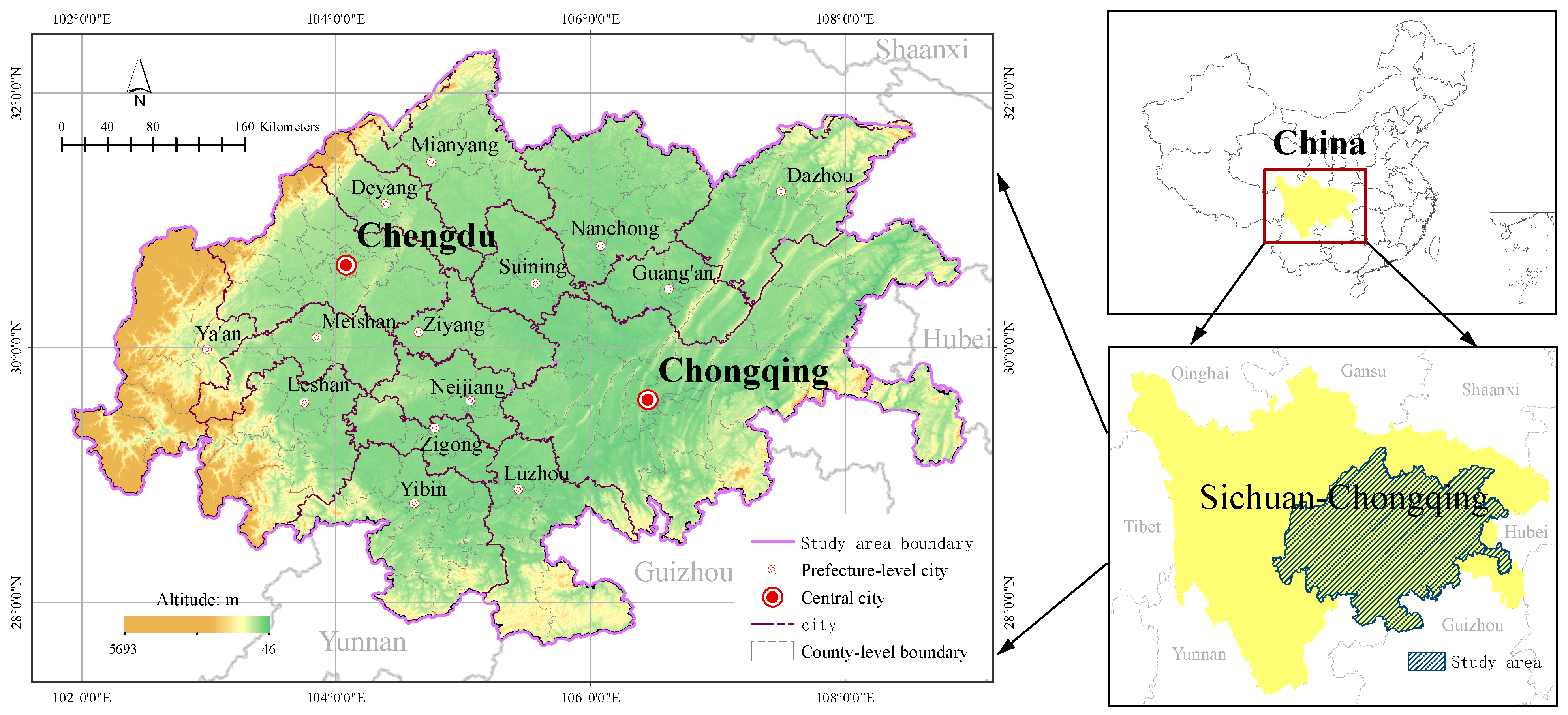
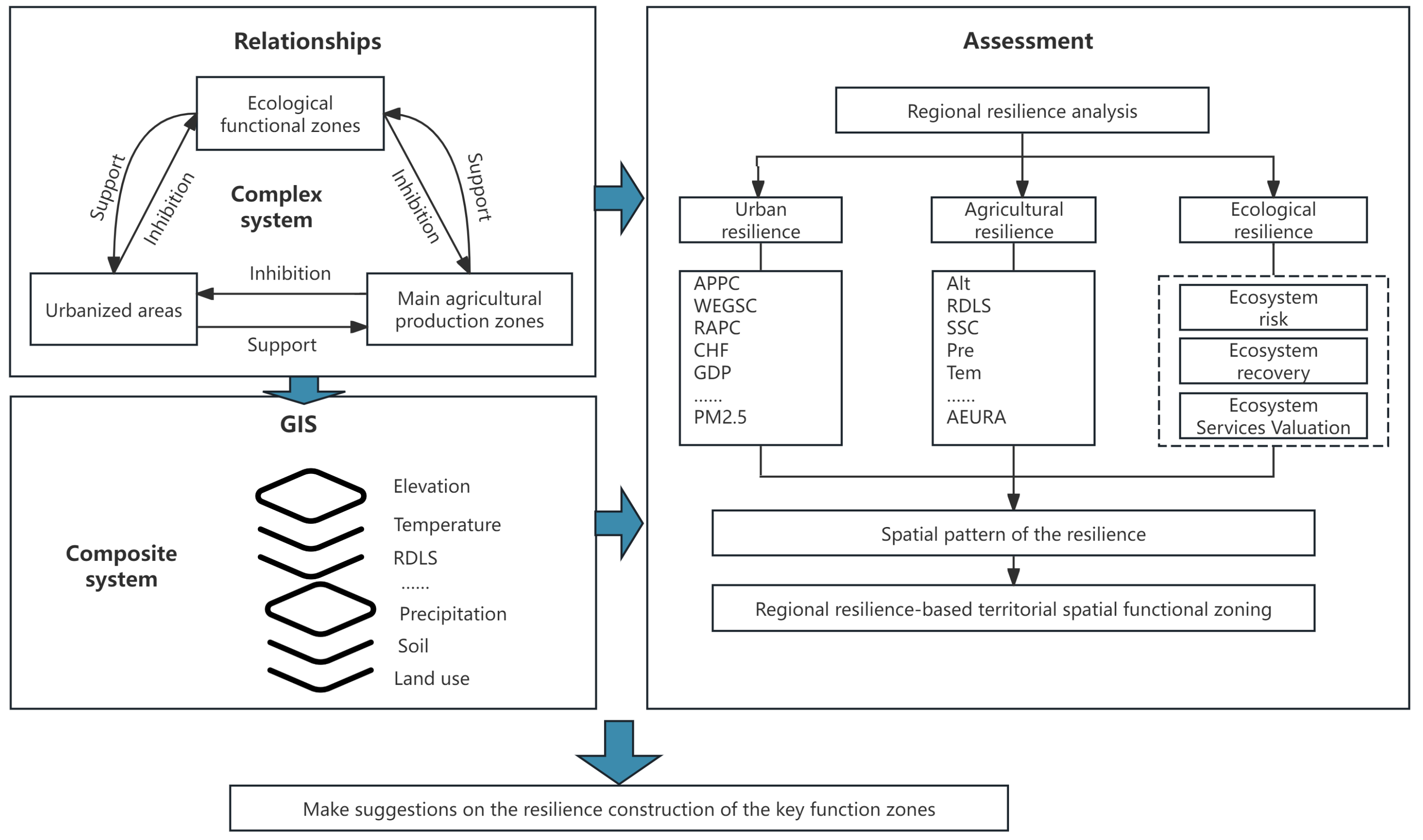


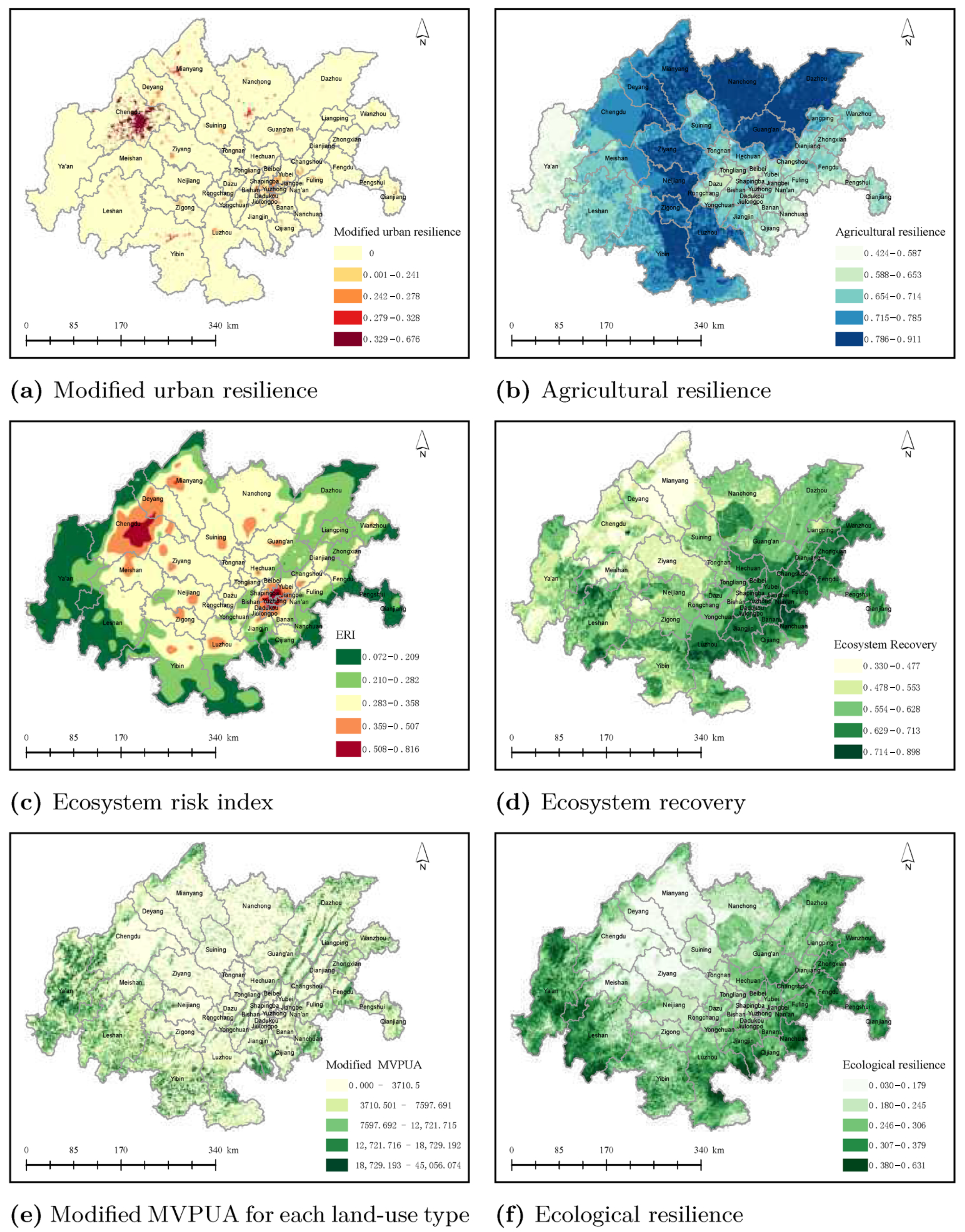
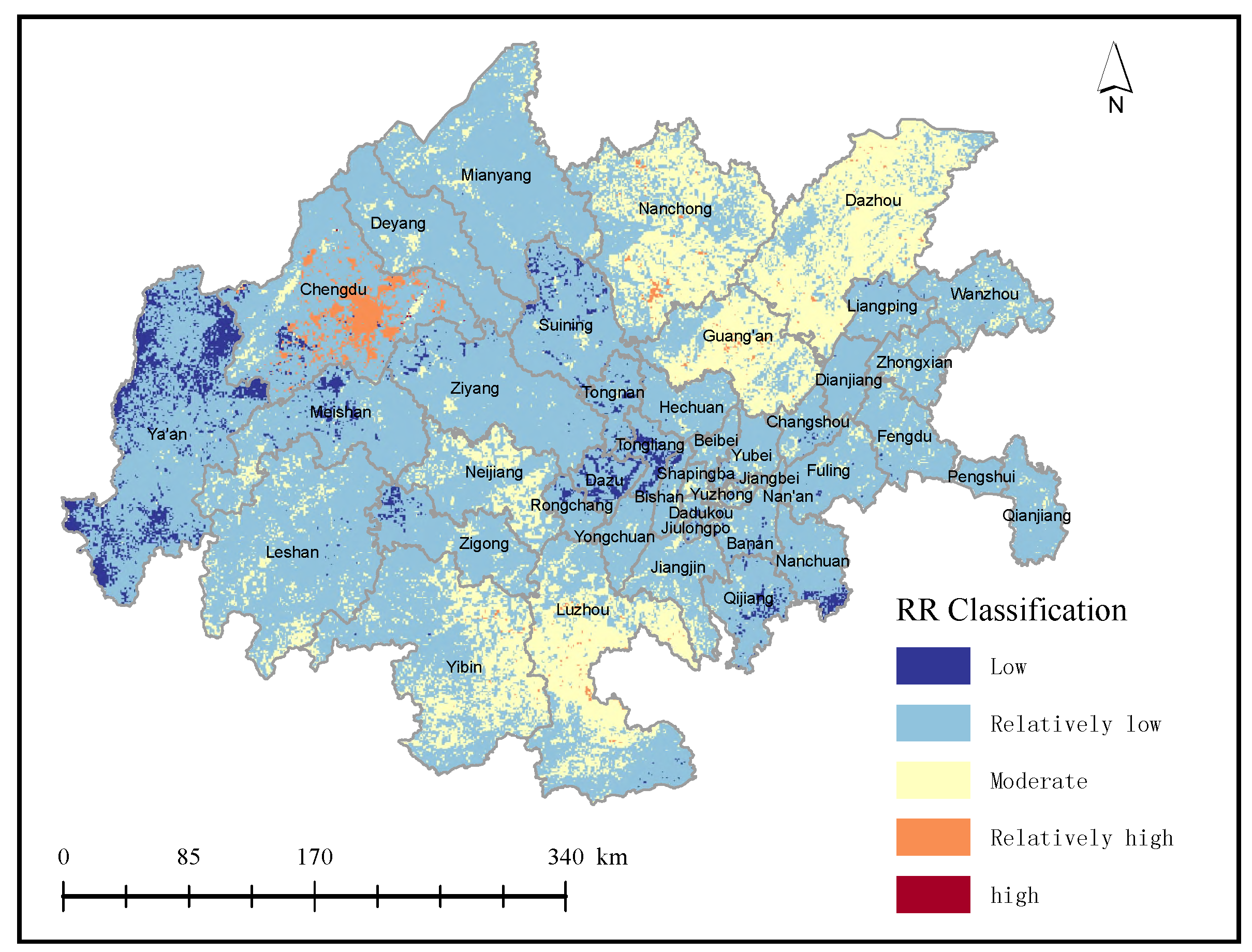

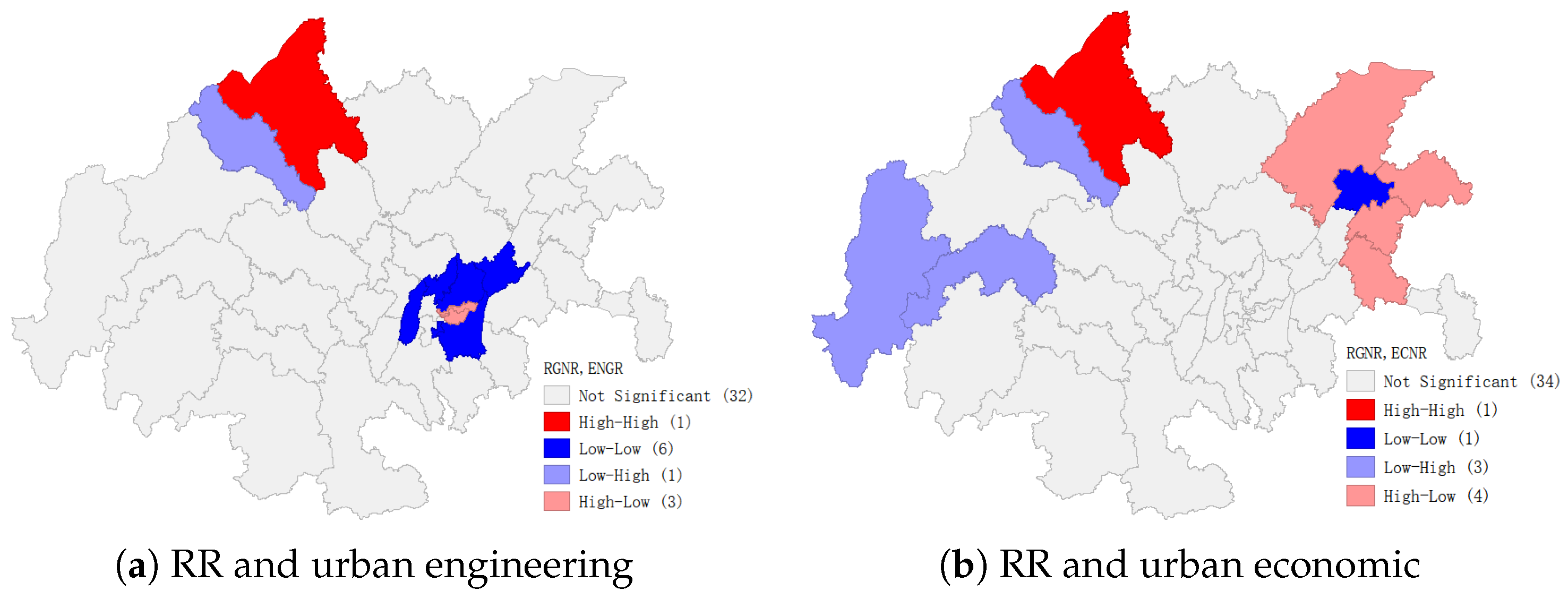
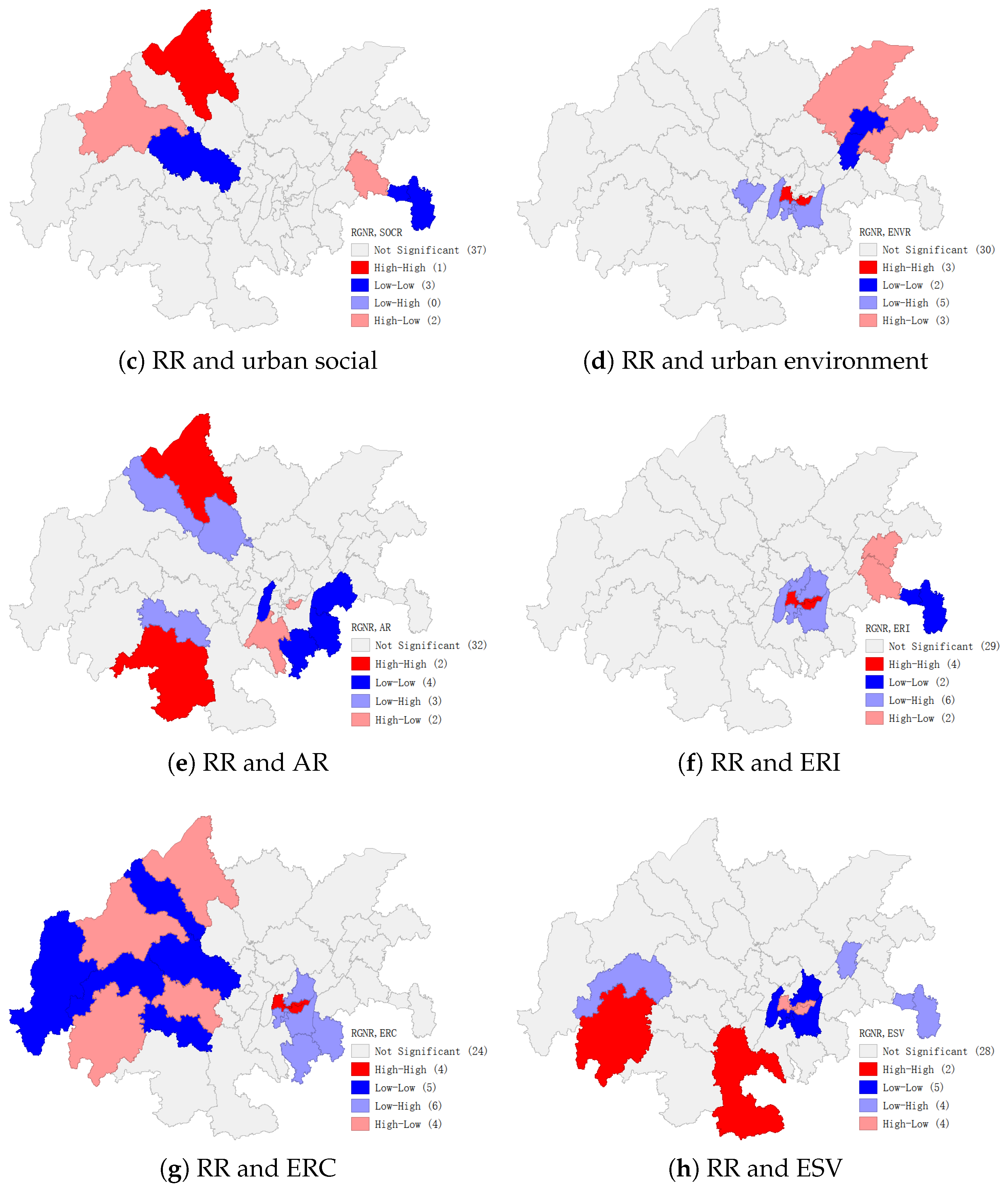
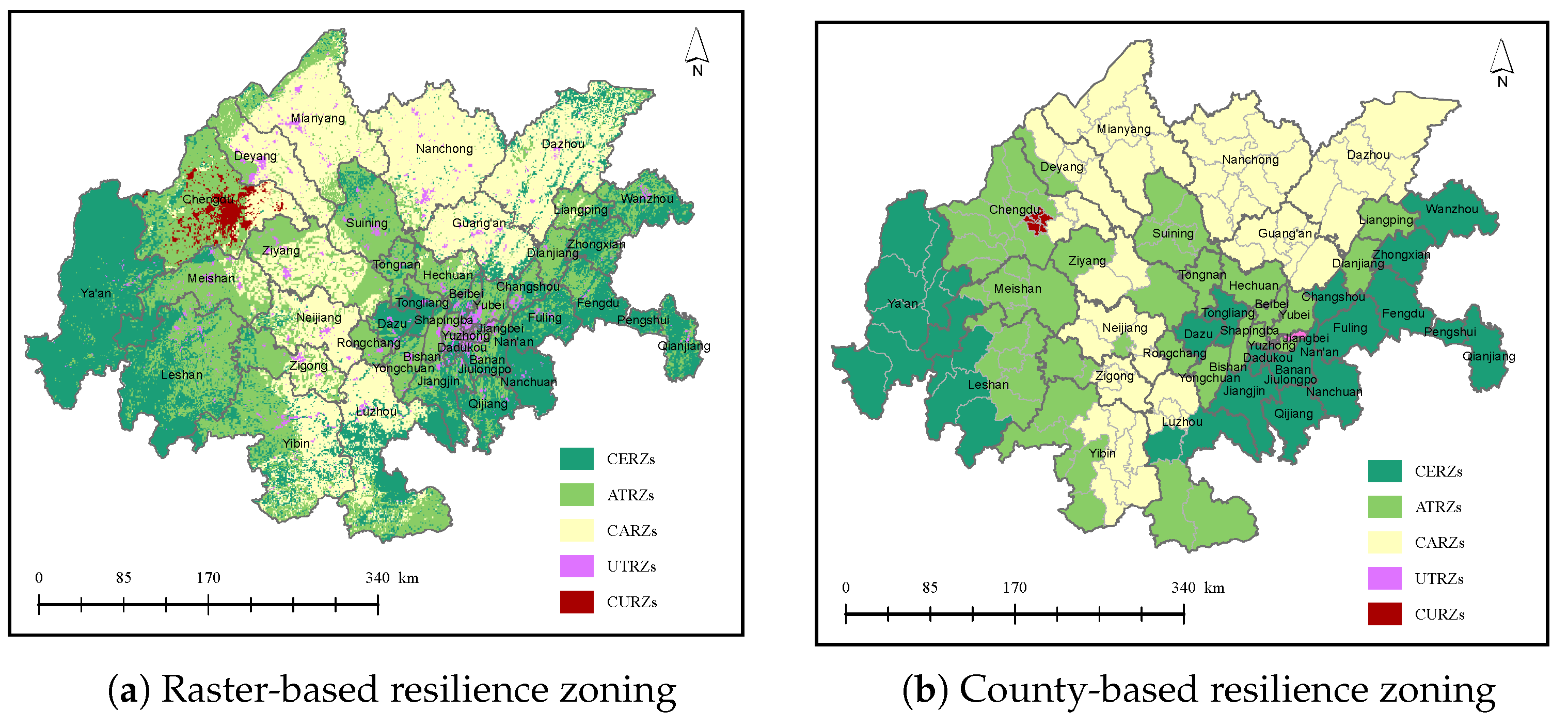
| Dimension | Key Indicators | Weight Method | Data Sources |
|---|---|---|---|
| Urban | APPC, WEGSC, RAPC, CHF, GDP, GDP per capita, PFE, FAIPF, RSDB, Population, PD, LSL, UR, CSO, HAPC, STR, DWDR, GR, ISWUR, PM 2.5 | Delphi, AHP | Statistical yearbooks 2019, Administrative-boundary data, land-use |
| Agricultural | Alt, RDLS, SSC, Pre, Tem, HSS, AIFFAHF, AFA, AEURA | Entropy | DEM, the World Soil Database, Climate dataset |
| Ecological | Land-use type, Soil fertility, Soil texture, Climate, Biodiversity | Adopted from papers | Land-use, NDVI, NPP the World Soil Database, Climate dataset |
| Target Level | Criteria Level | Weights | Alternatives Level | Weights |
|---|---|---|---|---|
| urban resilience | infrastructure resilience | 0.3124 | APPC | 0.0615 |
| WEGSC | 0.0936 | |||
| RAPC | 0.0694 | |||
| CHF | 0.0879 | |||
| economic resilience | 0.2562 | GDP | 0.0426 | |
| RSDB | 0.0407 | |||
| PFE | 0.0669 | |||
| GDP per capita | 0.0448 | |||
| FAIPF | 0.0612 | |||
| social resilience | 0.2335 | population | 0.0426 | |
| LSL | 0.0417 | |||
| PD | 0.0426 | |||
| UR | 0.0351 | |||
| CSO | 0.0322 | |||
| HAPC | 0.0393 | |||
| environmental resilience | 0.1979 | STR | 0.0358 | |
| DWDR | 0.0269 | |||
| GR | 0.0345 | |||
| ISWUR | 0.0412 | |||
| PM2.5 | 0.0585 |
| Tier 1 Indicators | Tier 2 Indicators | Tier 3 Indicators | Types | Weights |
|---|---|---|---|---|
| agricultural resilience | Physical factors | Alt | − | 0.094 |
| RDLS | − | 0.091 | ||
| SSC | − | 0.088 | ||
| Pre | + | 0.162 | ||
| Tem | + | 0.142 | ||
| HSS | + | 0.153 | ||
| Human factors | AIFFAHF | + | 0.097 | |
| AFA | + | 0.091 | ||
| AEURA | + | 0.082 |
| Land-Use Type | Woodland | Grasslands | Farmland | Water Body | Unused Land | Construction Land |
|---|---|---|---|---|---|---|
| ERI weight | 0.12 | 0.16 | 0.32 | 0.53 | 0.82 | 0.85 |
| Indicators | Responses Characteristics | Data | Weights |
|---|---|---|---|
| Soil fertility | Slow variable | Organic carbon content | 0.1382 |
| Soil texture | Soil texture | 0.2352 | |
| Climate | Average annual temperature | 0.1365 | |
| Average annual precipitation | 0.1694 | ||
| Biodiversity | Diversity | Species diversity index | 0.3207 |
| Function Types | Farmland | Woodland | Grassland | Water Body | Unused Land | Construction Land | |
|---|---|---|---|---|---|---|---|
| Supply services | Food production | 1553.51 | 512.66 | 668.01 | 823.36 | 31.07 | 0 |
| Raw material production | 605.87 | 4629.47 | 559.26 | 543.73 | 62.14 | 0 | |
| Regulatory services | Air conditioning | 1118.53 | 6711.17 | 2330.27 | 792.29 | 93.21 | 0 |
| Climate conditioning | 1506.91 | 6322.79 | 2423.48 | 3200.24 | 201.96 | 0 | |
| Hydrological conditioning | 1196.2 | 6353.86 | 2361.34 | 29,159.42 | 108.75 | 0 | |
| Waste treatment | 2159.38 | 2672.04 | 2050.64 | 23,069.66 | 403.91 | 0 | |
| Support Services | Soil conservation | 2283.66 | 6245.12 | 3479.87 | 636.94 | 264.1 | 0 |
| Maintaining biodiversity | 1584.58 | 7006.34 | 2905.07 | 5328.55 | 621.4 | 0 | |
| Cultural services | Providing an aesthetic landscape | 264.11 | 3231.31 | 1351.55 | 6897.59 | 372.84 | 0 |
| Total | 12,272.75 | 43,684.76 | 18,129.49 | 70,451.78 | 2159.38 | 0 | |
| RR Level | Area () | % of the Study Area |
|---|---|---|
| Low | 6907 | 3.73 |
| Relatively low | 134,514 | 72.72 |
| Moderate | 41,179 | 22.26 |
| Relatively high | 2361 | 1.28 |
| High | 15 | 0.01 |
| Total | 184,976 | 100.00 |
| Scheme | UR (%) | AR (%) | ER (%) | Fig. Label |
|---|---|---|---|---|
| 1 | 20 | 20 | 60 | a |
| 2 | 20 | 40 | 40 | b |
| 3 | 20 | 60 | 20 | c |
| 4 | 40 | 20 | 40 | d |
| 5 | 40 | 40 | 20 | e |
| 6 | 60 | 20 | 20 | f |
| Scheme | Low | Relatively Low | Moderate | Relatively High | High |
|---|---|---|---|---|---|
| Baseline | 3.73 | 72.72 | 22.26 | 1.28 | 0.01 |
| 1 (Eco) | 3.98 | 62.03 | 32.67 | 1.31 | 0.01 |
| 2 (Agro-Eco) | 0.60 | 41.80 | 54.12 | 3.47 | 0.01 |
| 3 (Agro) | 2.08 | 25.30 | 51.49 | 20.88 | 0.24 |
| 4 (Urban-Eco) | 18.58 | 76.56 | 3.82 | 1.04 | 0.00 |
| 5 (Urban-Agro) | 8.40 | 69.33 | 20.86 | 1.15 | 0.26 |
| 6 (Urban) | 75.31 | 21.87 | 1.76 | 0.02 | 1.03 |
| Resilience Evaluation Results | Territorial Spatial Resilience Zoning | ||
|---|---|---|---|
| Urban Resilience | Agricultural Resilience | Ecological Resilience | |
| High | High | High | CURZs |
| High | High | Moderate | CURZs |
| High | High | Low | CURZs |
| High | Moderate | High | CURZs |
| High | Moderate | Moderate | CURZs |
| High | Moderate | Low | CURZs |
| High | Low | High | CURZs |
| High | Low | Moderate | CURZs |
| High | Low | Low | CURZs |
| Moderate | High | High | UTRZs |
| Moderate | High | Moderate | UTRZs |
| Moderate | High | Low | UTRZs |
| Moderate | Moderate | High | UTRZs |
| Moderate | Moderate | Moderate | UTRZs |
| Moderate | Moderate | Low | UTRZs |
| Moderate | Low | High | UTRZs |
| Moderate | Low | Moderate | UTRZs |
| Moderate | Low | Low | UTRZs |
| Low | High | High | CERZs |
| Low | High | Moderate | CARZs |
| Low | High | Low | CARZs |
| Low | Moderate | High | CERZs |
| Low | Moderate | Moderate | ATRZs |
| Low | Moderate | Low | ATRZs |
| Low | Low | High | CERZs |
| Low | Low | Moderate | CERZs |
| Low | Low | Low | CERZs |
Disclaimer/Publisher’s Note: The statements, opinions and data contained in all publications are solely those of the individual author(s) and contributor(s) and not of MDPI and/or the editor(s). MDPI and/or the editor(s) disclaim responsibility for any injury to people or property resulting from any ideas, methods, instructions or products referred to in the content. |
© 2025 by the authors. Licensee MDPI, Basel, Switzerland. This article is an open access article distributed under the terms and conditions of the Creative Commons Attribution (CC BY) license (https://creativecommons.org/licenses/by/4.0/).
Share and Cite
He, X.; Wu, B.; Shen, G.; Fan, T. Spatial and Functional Heterogeneity in Regional Resilience: A GIS-Based Analysis of the Chengdu–Chongqing Economic Mega Region. Land 2025, 14, 1769. https://doi.org/10.3390/land14091769
He X, Wu B, Shen G, Fan T. Spatial and Functional Heterogeneity in Regional Resilience: A GIS-Based Analysis of the Chengdu–Chongqing Economic Mega Region. Land. 2025; 14(9):1769. https://doi.org/10.3390/land14091769
Chicago/Turabian StyleHe, Xindong, Boqing Wu, Guoqiang Shen, and Tian Fan. 2025. "Spatial and Functional Heterogeneity in Regional Resilience: A GIS-Based Analysis of the Chengdu–Chongqing Economic Mega Region" Land 14, no. 9: 1769. https://doi.org/10.3390/land14091769
APA StyleHe, X., Wu, B., Shen, G., & Fan, T. (2025). Spatial and Functional Heterogeneity in Regional Resilience: A GIS-Based Analysis of the Chengdu–Chongqing Economic Mega Region. Land, 14(9), 1769. https://doi.org/10.3390/land14091769





